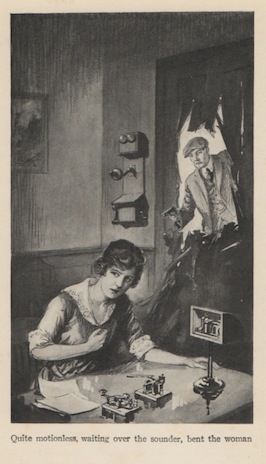The Window-Gazer
Isabel Ecclestone Mackay
Toronto: McClelland and Stewart, 1921
Lured by the offer of lodging, Great War veteran Prof Benis Harrison Spence has left his aunt's altogether too busy Ontario home for the quiet of coastal British Columbia.
It seemed like a good idea at the time.
Spence is burdened by several ounces of shrapnel and a nervous disorder, both souvenirs from his time at the Front; rest is just what the doctor – physician friend John Rogers – ordered.
Unfortunately, host Herbert Farr turns out to be an unstable, unlovable charlatan. The man's home is nothing more than a leaky, albeit spacious, cottage shared by daughter Desire and Chinese servant Li Ho. Spence has no sooner arrived when he collapses from stress placed upon his shrapnel-filled leg. Weeks pass, during which the professor is nursed back to health by young Desire.
Make nothing of her name.
Theirs is a platonic relationship with a foundation formed by shared interests and outlook on life. Neither cares much for marriage – "a hideous thing," says Desire. Spence proposes just the same as a means of freeing his newfound friend from her crazy father's clutches. Believing the professor to be the sort who will one day find true love, Desire declines. The quick thinking Spence comes up with a sad story about losing the love of his life, a blonde girl named "Mary", to another, which leads her to reconsider. After all, the professor is not a man to "love twice."
The pair run off to Vancouver, are married, and share a chaste working honeymoon in separate tents on fictitious Friendly Bay. They soon settle in Bainbridge, an Ontario town beset by blonde Marys.
 |
| Canadian Bookman, February 1922 |
"A Jap?" exclaimed Spence in surprise.Spence's aunt allows that she doesn't mind having her luggage handled by Pullman porters, but she does worry that her nephew's new bride might be part Indian. Her concern is shared by the gentile ladies of Bainbridge. "Well, if Indian blood can give one a skin like hers, I could do with an offside ancestor myself!" one writes in a letter.
"No. He's Indian. Some of the babies are so Japaneesy that it's hard to tell the difference. Father says it's a strain of the same blood."
And then we have Li Ho, who is described by a less than honest boatman as "one of the Chinkiest Chinamen I ever seen." For much of the novel, Farr's servant appears as a stereotype out of… well, something published early last century. He speaks in a manner that will make today's reader cringe – "Me much glad Missy get mallied" – only to be revealed as the most intelligent of Mackay's creations. Indeed, he is the one character to really display character. In the end, Li Ho proves to be the hero of the novel, a fact ignored by reviewers of the day.
I wonder why?
About the title:
When I was younger and we lived in towns I used to wander off by myself down the main streets to gaze in the windows. I never went into any of the stores. The things I wanted were inside and for sale – but I could not buy them. I was just a window-gazer. That's what I am still. Life is for sale somewhere. But I cannot buy it.Object: A 308-page hardcover bound in blue cloth. The design was shared with the American edition published by Doran. I've not seen a dust jacket for either. I purchased my copy for $3.75 last December from a London bookseller
Access: The Doran and McClelland & Stewart editions enjoyed just one printing each. As might be expected, Library and Archives Canada has neither. Does Interim Librarian and Archivist Hervé Déry care? Perhaps not – after all, the man is an economist, not a librarian or archivist. Anyway, his position is only interim; it's been only a year since James Moore appointee Déry took over from disgraced James Moore appointee Daniel J. Caron. What's the rush?
Twenty-eight copies of the McClelland and Stewart edition are held by Canadian libraries, though only the Toronto Public Library and Vancouver Public Library serve the… um, public.
Eighty-one copies are listed for sale online, but seventy-seven of these come from print on demand vultures. As is invariably the case, they provide some amusing covers. Tutis has a good one, but my favourite comes from Read How You Want, which not only changes Desire's gender and transports her to Paris, so that she/he might to look over the Rue de Miromesni.
Not one of the other four copies has a dust jacket. At US$25, the cheapest is a Good copy of the Doran edition. Next up in terms of price – US$35 and US$47 – are two passable copies of that issued by McClelland & Stewart. The Vermont bookseller with the absurd prices is trying to flog a "discoloured from damp" signed copy of the first edition – whether Doran or McClelland and Stewart he does not say. Either way, at US91.98 it is horribly overpriced; no one is much interested in signed Mackay's – except, maybe, me.





























